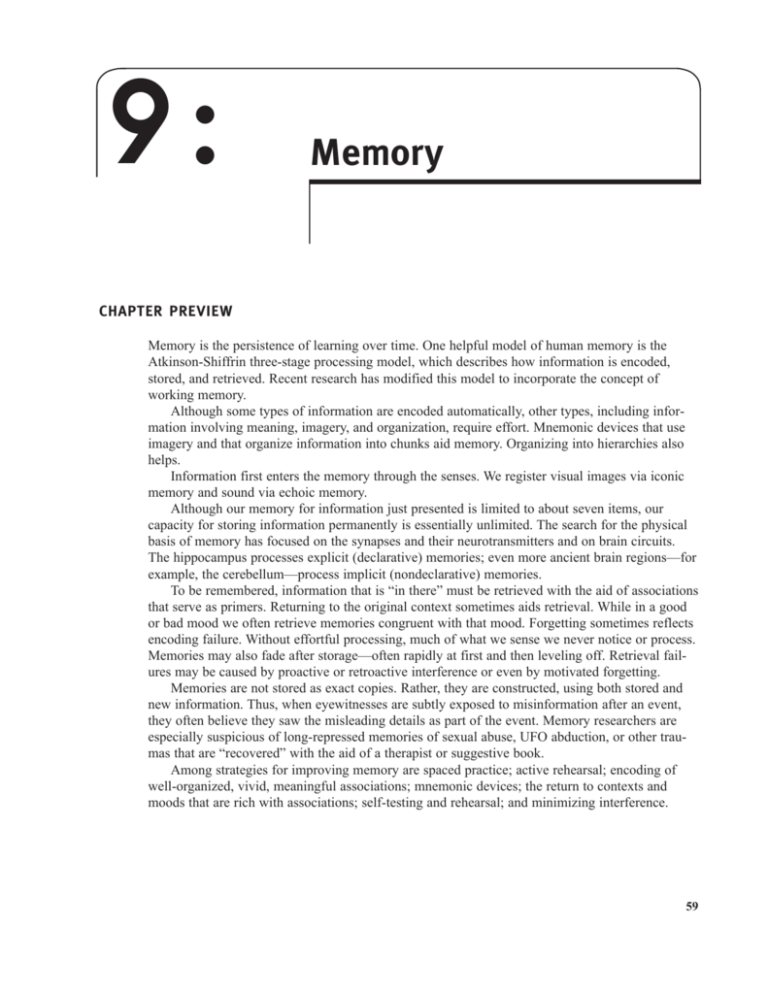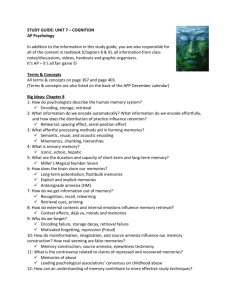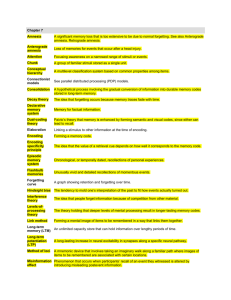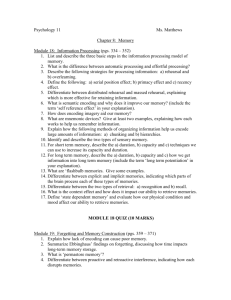Chapter 9 Memory
advertisement

9: Memory CHAPTER PREVIEW Memory is the persistence of learning over time. One helpful model of human memory is the Atkinson-Shiffrin three-stage processing model, which describes how information is encoded, stored, and retrieved. Recent research has modified this model to incorporate the concept of working memory. Although some types of information are encoded automatically, other types, including information involving meaning, imagery, and organization, require effort. Mnemonic devices that use imagery and that organize information into chunks aid memory. Organizing into hierarchies also helps. Information first enters the memory through the senses. We register visual images via iconic memory and sound via echoic memory. Although our memory for information just presented is limited to about seven items, our capacity for storing information permanently is essentially unlimited. The search for the physical basis of memory has focused on the synapses and their neurotransmitters and on brain circuits. The hippocampus processes explicit (declarative) memories; even more ancient brain regions—for example, the cerebellum—process implicit (nondeclarative) memories. To be remembered, information that is “in there” must be retrieved with the aid of associations that serve as primers. Returning to the original context sometimes aids retrieval. While in a good or bad mood we often retrieve memories congruent with that mood. Forgetting sometimes reflects encoding failure. Without effortful processing, much of what we sense we never notice or process. Memories may also fade after storage—often rapidly at first and then leveling off. Retrieval failures may be caused by proactive or retroactive interference or even by motivated forgetting. Memories are not stored as exact copies. Rather, they are constructed, using both stored and new information. Thus, when eyewitnesses are subtly exposed to misinformation after an event, they often believe they saw the misleading details as part of the event. Memory researchers are especially suspicious of long-repressed memories of sexual abuse, UFO abduction, or other traumas that are “recovered” with the aid of a therapist or suggestive book. Among strategies for improving memory are spaced practice; active rehearsal; encoding of well-organized, vivid, meaningful associations; mnemonic devices; the return to contexts and moods that are rich with associations; self-testing and rehearsal; and minimizing interference. 59 60 Chapter 9 Memory CHAPTER GUIDE ➤ Introductory Exercise: Fact or Falsehood? ➤ Feature Film: Eternal Sunshine of the Spotless Mind ➤ Video: Module 13 of Psychology: The Human Experience: What Is Memory? The Phenomenon of Memory ➤ Exercises: Remembering the Seven Dwarfs; Flashbulb Memory; Forgetting Frequency Questionnaire; Bias in Memory ➤ Lectures: The World Memory Championships; The Case of Clive Wearing ➤ Videos: Module 10 of The Mind, 2nd ed.: Life Without Memory: The Case of Clive Wearing, Part 1; Module 11 of The Mind, 2nd ed.: Clive Wearing, Part 2: Life Without Memory; Video Clip 25 of Digital Media Archive: Psychology: Clive Wearing: Living Without Memory; Module 14 of Psychology: The Human Experience: Flashbulb Memories; Discovering Psychology, Updated Edition: Memory ➤ Transparency: 103 A Modified Three-Stage Processing Model of Memory 1. Define memory, and explain how flashbulb memories differ from other memories. Memory is the persistence of learning over time through the storage and retrieval of information. Flashbulb memories are clear memories of emotionally significant moments or events and thus differ from other memories in their striking clarity. 2. Describe Atkinson-Schiffrin's classic three-stage processing model of memory, and explain how the contemporary model of working memory differs. In some ways, our memory is like a computer’s information-processing system. Information must be encoded, stored, and retrieved. The Atkinson-Shiffrin three-stage processing model states that we first record to-be-remembered information as a fleeting sensory memory, from which it is processed into a short-term memory bin, where we encode it through rehearsal for long-term memory and later retrieval. Contemporary memory researchers note that we sometimes bypass the first two stages and register some information automatically. They also prefer the term working memory to short-term memory because it emphasizes a more active role in the second processing stage where we rehearse information and associate new stimuli with existing memories. The working-memory model includes visual-spatial and auditory subsystems, coordinated by a central executive processor that focuses attention where needed. The episodic buffer helps the central executive integrate input in a way we can comprehend. Encoding: Getting Information In ➤ Exercises: Rehearsal and the Twelve Days of Christmas; Serial Position Effect in Recalling U.S. Presidents; Visually Versus Auditorily Encoded Information; The Self-Reference Effect; Meaning and Memory; Semantic Encoding of Pictures; Chunking ➤ Lectures: Mnemonic Devices; The Keyword Method ➤ Transparencies: 104 Ebbinghaus' Retention Curve; 105 Levels of Processing 3. Describe the types of information we encode automatically. To some extent, encoding occurs automatically. With little or no effort, we encode an enormous amount of information about space, time, and frequency. For example, we can recreate a sequence of the day’s events in order to guess where we might have left a coat. Automatic processing occurs without our awareness and without interfering with our thinking about other things. Some forms of processing, such as learning to read or drive, require attention and effort when we first perform them but with practice become automatic. Chapter 9 Memory 61 4. Contrast effortful processing with automatic processing, and discuss the next-in-line effect, the spacing effect, and the serial position effect. Automatic processing occurs unconsciously; effortful processing requires attention and effort. For example, our memory of a new telephone number will disappear unless we work to maintain it in consciousness. The next-in-line effect is our tendency to forget what the person ahead of us in line has said because we are focusing on what we will say in our upcoming turn to speak. The spacing effect is our tendency to retain information more easily if we practice it repeatedly than if we practice it in one long session. The serial position effect is our tendency to remember the last and first items in a long list (for example, a grocery list) better than the middle items. 5. Compare the benefits of visual, acoustic, and semantic encoding in remembering verbal information, and describe a memory-enhancing strategy related to the self-reference effect. When processing verbal information for storage, we usually encode its meaning. For example, we associate it with what we already know or imagine. Research indicates that semantic encoding (of meaning) yields better memory of verbal information than acoustic encoding (of sound) or visual encoding (of an image). This research also highlights the futility of trying to remember words we do not understand and the benefits of rephrasing what we read and hear into meaningful terms. The self-reference effect suggests that by making information “relevant to me,” we process it more deeply, and the information will remain more easily accessible. 6. Explain how encoding imagery aids effortful processing, and describe some memory-enhancing strategies that use visual encoding. In a variety of experiments, researchers have documented the benefits of mental imagery. For example, we remember words that lend themselves to picture images better than we remember abstract, low-imagery words. We remember concrete nouns better than abstract nouns because, for example, we can associate both an image and a meaning with tiger but only a meaning with process. Imagery is at the heart of many memory aids, or mnemonics. For example, in the “method of loci,” speakers remember their main points by associating them with a familiar series of locations such as the rooms and objects in their house. 7. Discuss the use of chunking and hierarchies in effortful processing. When we organize information into meaningful units, we recall it more easily. In chunking, we cluster information into familiar, manageable units, such as words into sentences. Chunking occurs so naturally that we often take it for granted. When people develop expertise in an area, they often process information in hierarchies composed of a few broad concepts divided and subdivided into lesser concepts and facts. In this way, experts can retrieve information efficiently. Storage: Retaining Information ➤ Exercises: Iconic Memory; Memory Capacity ➤ Lectures: Rajan Mahadevan’s Amazing Memory; Episodic, Semantic, and Procedural Memory ➤ Feature Film: Memento ➤ Videos: Module 20 of The Brain Series, 2nd ed.: A Super-Memorist Advises on Study Strategies; Modules 16, 17, and 18 of The Brain Series, 2nd ed.: The Locus of Learning and Memory, Living with Amnesia: Learning as Synaptic Change, and The Hippocampus and Memory; Segment 16 of the Scientific American Frontiers Series, 2nd ed.: Remembering What Matters ➤ PsychSim 5: Iconic Memory; Short-Term Memory; When Memory Fails ➤ Transparency: 106 Memory Subsystems 8. Contrast two types of sensory memory. Information first enters the memory system through the senses. Iconic memory is a momentary sensory memory of visual stimuli, a photographic or picture-image memory lasting less than a second. Echoic memory is a momentary sensory memory of auditory stimuli. Even if attention is elsewhere, sounds and words can still be recalled within three or four seconds. 62 Chapter 9 Memory 9. Describe the duration and working capacity of short-term memory. Our short-term memory span for information just presented is very limited—a seconds-long retention of up to about seven items, depending on the information and how it is presented. Short-term recall is better for digits than for letters, and better for what we hear than what we see. 10. Describe the capacity and duration of long-term memory. Although we know that our capacity for storing information permanently is essentially unlimited, we are not sure how and where we store it. Research has shown that memories do not reside in a single place and the so-called memory trace is difficult to find. 11. Discuss the synaptic changes that accompany memory formation and storage. The search for the physical basis of memory has recently focused on the synapses and their neurotransmitters and on the long-term potentiation (LTP) of brain circuits. In response to increased activity in neural pathways, neural interconnections form or strengthen. Studies of the sea snail indicate that when learning occurs, the snail releases more of the neurotransmitter serotonin at certain synapses, and these synapses become more efficient at transmitting signals. In experiments, rapidly stimulating certain memory-circuit connections has increased their sensitivity for weeks to come. This LTP appears to be a neural basis for learning and remembering associations. Drugs that block LTP interfere with learning. Scientists are developing drugs that boost the production of the protein CREB or the neurotransmitter glutamate, which seem to build synaptic connections and enhance long-term memory. 12. Discuss some ways stress hormones can affect memory. The naturally stimulating hormones that humans and animals produce when excited or stressed make more glucose energy available to fuel brain activity, signaling the brain that something important has happened. The amygdala, an emotion-processing structure in the brain’s limbic system, arouses brain areas that process emotion. These emotion-triggered hormonal changes boost learning and retention. Emotionless events mean weaker memories. 13. Distinguish between implicit and explicit memory, and identify the main brain structure associated with each. Studies of brain-damaged patients who suffer amnesia reveal two types of memory. Implicit memory (procedural memory) is retention without conscious recollection (of skills, preferences, and dispositions). Explicit memory (declarative memory) is the memory of facts and experiences that one can consciously know and “declare.” This dual-memory system helps explain infantile amnesia. The hippocampus is a limbic system structure that plays a vital role in the gradual processing of our explicit memories into long-term memory. When monkeys and people lose their hippocampus to surgery or disease, they lose most of their recall for things learned during the preceding month. Older memories remain intact, suggesting that the hippocampus is not the permanent storehouse, but a loading dock that feeds new information to other brain circuits for permanent storage. Implicit memories are processed by the more ancient cerebellum. Research with rabbits in which different parts of the neural pathway were temporarily deadened during eye-blink training pinpointed implicit memory in the cerebellum at the back of the head. Chapter 9 Memory 63 Retrieval: Getting Information Out ➤ ➤ ➤ ➤ Projects: Permastore; Retrieval Cues Exercises: Expertise and Retrieval Rate; Déjà Vu in the Classroom; The Polyanna Principle Lecture: The Déjà Vu Illusion Video: Video Clip 24 of Digital Media Archive: Psychology: Aging and Memory 14. Contrast the recall, recognition, and relearning measures of memory. Recall is a measure of memory in which the person must retrieve information learned earlier, as on a fill-in-the-blank test. Recognition is a measure in which a person need only identify items previously learned, as on a multiple-choice test. Relearning is a memory measure that assesses the amount of time saved when relearning previously learned information. Tests of recognition and relearning reveal that we remember more than we recall. 15. Explain how retrieval cues help us access stored memories, and describe the process of priming. We can think of a memory as held in storage by a web of associations. Retrieval cues are bits of related information we encode while encoding a target piece of information. They become part of the web. To retrieve a specific memory, we need to identify one of the strands that leads to it, a process called priming. Activating retrieval cues within our web of associations aids memory. 16. Cites some ways that context can affect retrieval. Retrieval is sometimes aided by returning to the original context in which we experienced an event or encoded a thought. It can flood our memories with retrieval cues that lead to the target memory. Sometimes, being in a context similar to one we’ve been in before may trick us into unconsciously retrieving the target memory. The result is a feeling that we are reliving something that we have experienced before—a phenomenon known as déjà vu. 17. Describe the impact of internal states on retrieval. State-dependent memory is the tendency to recall information best in the same emotional or physiological state as when the information was learned. Memories are somewhat mood-congruent. While in a good or bad mood, we often retrieve memories consistent with that mood. Moods also prime us to interpret others’ behavior in ways consistent with our emotions. Forgetting ➤ Exercises: Memory of a Penny; Encoding Failure; The Tip-of-the-Tongue Phenomenon and Capital Cities; Repression or Inadequate Retrieval Cues? ➤ Lectures: Change Blindness; Suppressed Memory ➤ Projects: A Forgetting Journal; Earliest Recollections ➤ PsychSim 5: Forgetting ➤ Transparencies: 107 Forgetting as Encoding Failure; 108 Ebbinghaus’ Forgetting Curve; 109 Retrieval Failure; 110 Retroactive Interference 18. Explain why we should value our ability to forget, and distinguish three general ways our memory fails us. The capacity to forget useless or out-of-date information is helpful. Because of his inability to forget, the Russian memory whiz S found it more difficult than others to think abstractly—to generalize, to organize, to evaluate. Without an ability to forget we would be overwhelmed by outof-date and irrelevant information. Our memories fail us through forgetting (absent-mindedness, transience, and blocking), through distortion (misattribution, suggestibility, and bias), and through intrusion (persistence of unwanted memories). 19. Discuss the role of encoding failure in forgetting. One explanation for forgetting is that we fail to encode information for entry into our memory system. Without effortful processing, much of what we sense we never notice or process. For 64 Chapter 9 Memory example, although most people in the United States have probably looked at thousands of pennies, when tested on specific features they have difficulty recognizing the real thing. 20. Discuss the concept of storage decay, and describe Ebbinghaus’ forgetting curve. Memories may fade after storage. From his research on learning and retention, Ebbinghaus found that forgetting occurs rapidly at first, and then levels off. This principle became known as the forgetting curve. Storage decay may reflect a gradual fading of the physical memory trace. Another possible explanation is that we simply can’t retrieve the information. 21. Contrast proactive and retroactive interference, and explain how they can cause retrieval failure. Retrieval failure can occur if we have too few cues to summon information from long-term memory. It may also happen when old and new information compete for retrieval. In proactive interference, something we learned in the past interferes with our ability to recall something we have recently learned. In retroactive interference, something we have recently learned interferes with something we learned in the past. 22. Summarize Freud’s concept of repression, and state whether this view is reflected in current memory research. With his concept of repression, Sigmund Freud proposed that our memories are self-censoring. To protect our self-concepts and to minimize anxiety, we may block from consciousness painful memories and unacceptable impulses. In Freud’s view, this motivated forgetting submerges memories but leaves them available for later retrieval under the right conditions. Increasing numbers of memory researchers think repression rarely, if ever, occurs. Memory Construction ➤ Lectures: Misremembering the Causes of Behavior; The Misinformation Effect; Source Amnesia; True Photos and False Memories; False Memories Surrounding the Iraq War; Repressed Memories of Abuse ➤ Exercises: Creating a False Memory; Eyewitness Testimony—What Have We Learned?; Eyewitness Recall ➤ Project: Constructive Memory ➤ PsychSim 5: Trusting Your Memory ➤ Videos: Program 13 of Moving Images: Exploring Psychology Through Film: False Memories: Imagination Effects; Segment 17 of the Scientific American Frontiers Series, 2nd ed.: True or False? ➤ Transparency: 111 Levels of Analysis for the Study of Memory 23. Explain how misinformation and imagination can distort our memory of an event. Memories are not stored as exact copies, and they certainly are not retrieved as such. Rather, we construct our memories, using both stored and new information. In many experiments around the world, people have witnessed an event, received or not received misleading information about it, and then taken a memory test. The repeated result is a misinformation effect: After exposure to subtle misinformation, many people misremember. Asking leading questions can plant false memories. As people recount an experience, they fill in their memory gaps with plausible guesses. Other vivid retellings may also implant false memories. Even repeatedly imagining and rehearsing nonexistent events can create false memories. 24. Describe source amnesia’s contribution to false memories. When we encode memories, we distribute different aspects of them to different parts of the brain. Our memory for the source of an event is particularly frail. In source amnesia, we attribute to the wrong source an event that we have experienced, heard about, read about, or imagined. Thus, we may recognize someone but have no idea where we have seen the person. Or we imagine or dream an event and later are uncertain whether it actually happened. Source amnesia is one of the main components of false memories. Chapter 9 Memory 65 25. List some differences and similarities between true and false memories. Unreal memories feel like real memories. Neither the sincerity nor the longevity of a memory signifies that it is real. The most confident and consistent eyewitnesses are often not the most accurate. Memories of imagined experiences are usually limited to the gist of the supposed event—the meanings and feelings we associate with it. True memories contain more details than imagined ones. 26. Give arguments supporting and rejecting the position that very young children’s reports of abuse are reliable. A supporting argument is that even very young children can accurately recall events if a neutral person talks to them in words they can understand, asks nonleading questions, and uses the cognitive interview technique. A challenging argument is that preschoolers are more suggestible than older children or adults, and they can be induced, through suggestive questioning, to report false events. 27. Discuss the controversy over reports of repressed and recovered memories of childhood sexual abuse. Innocent people have been falsely convicted of abuse that never happened, and true abusers have used the controversy over recovered memories to avoid punishment. Forgetting of isolated past events, both negative and positive, is an ordinary part of life. Cued by a remark or an experience, we may later recover a memory. Controversy, however, focuses on whether the unconscious mind forcibly represses painful experiences and whether they can be retrieved by therapist-aided techniques. Memories “recovered” under hypnosis or drugs are especially unreliable as are memories of things happening before age 3. Traumatic experiences are usually vividly remembered, not banished into an active but inaccessible unconscious. Improving Memory ➤ Lecture: Making Doctors’ Instructions More Memorable 28. Explain how an understanding of memory can contribute to effective study techniques. The psychology of memory suggests several effective study strategies. These include overlearning, using spaced practice; active rehearsal; making new material personally meaningful by relating it to what is already known; mnemonic techniques; mentally recreating the contexts and moods in which the original learning occurred in order to activate retrieval cues; recording memories before misinformation can corrupt them; minimizing interference, for example, by studying just before sleeping; and testing one’s knowledge both to rehearse it and to determine what must still be learned.








